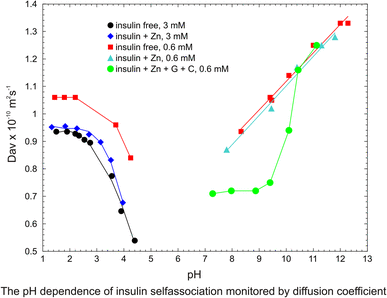Insight into human insulin aggregation revisited using NMR derived translational diffusion parameters
Jerzy Sitkowski, Wojciech Bocian, Elżbieta Bednarek, Mateusz Urbańczyk, Wiktor Koźmiński, Piotr Borowicz, Grażyna Płucienniczak, Natalia Łukasiewicz, Iwona Sokołowska, Lech Kozerski

The NMR derived translational diffusion coefficients were performed on unlabeled and uniformly labeled 13C,15N human insulin in water, both in neat, with zinc ions only, and in pharmaceutical formulation, containing only m-cresol as phenolic ligand, glycerol and zinc ions. The results show the dominant role of the pH parameter and the concentration on aggregation. The diffusion coefficient Dav was used for monitoring the overall average state of oligomeric ensemble in solution. The analysis of the experimental data of diffusion measurements, using the direct exponential curve resolution algorithm (DECRA) allows suggesting the two main components of the oligomeric ensemble. The 3D HSQC-iDOSY, (diffusion ordered HSQC) experiments performed on 13C, 15N-fully labeled insulin at the two pH values, 4 and 7.5, allow for the first time a more detailed experimental observation of individual components in the ensemble. The discussion involves earlier static and dynamic laser light scattering experiments and recent NMR derived translational diffusion results. The results bring new informations concerning the preparation of pharmaceutical formulation and in particular a role of Zn2+ ions. They also will enable better understanding and unifying the results of studies on insulin misfolding effects performed in solution by diverse physicochemical methods at different pH and concentration.
